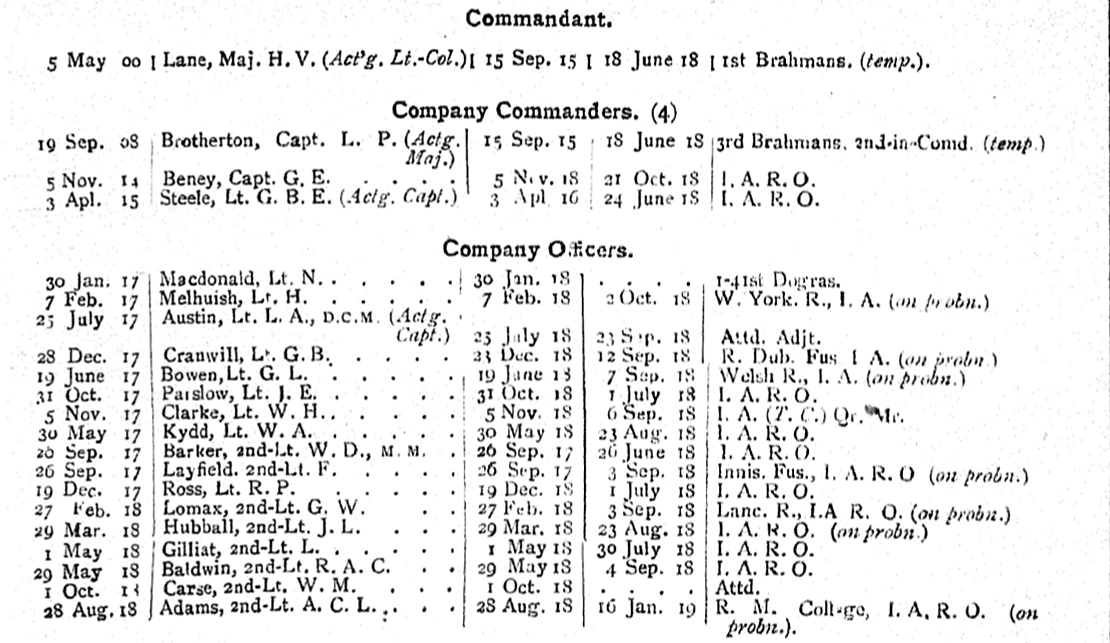This article is about the short-lived 2nd Battalion 3rd Gaur Brahmans and will help you to research the Battalion and those who served with it. I have written a separate article for the 1st Battalion 3rd Brahmans and a series of guides to researching soldiers who served in the Indian Army during the First World War:
The 2nd Battalion 3rd Gaur Brahmans in the First World War
Lineage: The 2nd Battalion 3rd Gaur Brahmans was formed at Deesa in what is now the Indian state of Gujarat in June 1918 and disbanded in 1920. For a history of the Regiment’s lineage see my page on the 1st Battalion 3rd Brahmans.
Class Composition of Battalion in 1919: 2 Companies of Gaur Brahmans and 2 Companies of Oudh Brahmans.
The 2nd Battalion 3rd Gaur Brahmans was a short-lived Indian infantry battalion raised at Deesa in June 1918. The first commanding officer was Major (Acting Lieutenant-Colonel) Henry Vials Lane, 1st Brahmans, who was appointed to the Battalion on 18 June 1918. The majority of British officers who served with the Battalion were either drawn from the Indian Army Reserve of Officers or were Indian Army officers on probation. As such, they were very inexperienced, as were the majority of Indian officers serving with the Battalion. In January 1919 the Battalion was still based at Deesa where it was serving as part of the 5th (Mhow) Division. It was noted as still being under formation at the time.
The page below was taken from the April 1919, Indian Army List and recorded just how inexperienced the British officers serving with the 2nd Battalion 3rd Gaur Brahmans were. The first column is the date of their first commission, while the third column is when they were appointed to the Battalion. Of the 21 British officers, only two had received their commission before the outbreak of war. Lieutenant Austin and Second Lieutenant Barker had both been decorated for gallantry while serving in the ranks before they were commissioned. Austin had won the Distinguished Conduct Medal and Barker the Military Medal.
I inspected this new unit 5th September 1918, when it was in a very backward and disorganised state and 1,550 strong.
Since then it was swollen to over 3,000 by drafts of Oude Brahmans and serious disturbances took place between them and the Gaur Brahmans, which were well handled by the Commanding Officer Lieutenant-Colonel Lane. Since then the Oude Brahmans have been drafted elsewhere and the Battalion has settled down but is still backward and several officers, British and Indian, are badly reported on.
Confidential review reports on Indian Army units, depots, British officers, etc. for 1918-1919: IOR/L/MIL/7/17030
The confidential report for Lieutenant-Colonel Lane recorded the date of the disturbance between the Gaur and Oude Brahmans as having occurred on 16 October 1918. Unfortunately, no further information was recorded. By June 1919, the 2nd Battalion 3rd Gaur Brahmans was stationed at Ahmedabad. The Battalion was inspected by Brigadier-General C. Clery, C.B. Commanding 10th Infantry Brigade, for its second review. In a report dated 25 May 1920, he wrote:
Instruction and training: Since the arrival of the unit from India it has constantly been split up in detachments on railway security and other duties, and the training has consequently suffered and is in a very backward state. The unit has also suffered from lack of experienced British Officers, Indian Officers and Non-Commissioned Officers. Elementary drill and musketry is all that is being attempted at present. An experienced officer [Major K. E. Kirkpatrick] has recently taken over command and is making every endeavour to remedy this state of affairs.
Physical appearance and training: The men do not look very robust, considerable more training required.
Discipline: Satisfactory.
Books, records, etc.: Some books require bringing up to date, this is being done.
Interior economy: Satisfactory.
General observations: Not at present fit for active service, fit for garrison duty only.
The interior economy has until recently been somewhat neglected due to the inexperience of the British Officers in dealing with Indian troops. The Subadar-Major is going to be tried shortly on a charge of misappropriation of Government rations, this is due a great deal to lack of supervision by the British Officers. More experienced Indian Officers and Non-Commissioned Officers are urgently required.
Confidential review reports on Indian Army units, depots, British officers, etc. for 1919-1920: IOR/L/MIL/7/17031
In June 1920, the Battalion had been stationed at Quetta where it was part of the 4th (Quetta) Division. Its Depot was based at Ahmedabad. Due to its poor reports, the Battalion was disbanded in 1920.
War Diaries for the 2nd Battalion 3rd Gaur Brahmans
There are no war diaries for the 2nd Battalion 3rd Gaur Brahmans.
Further Sources for the 2nd Battalion 3rd Gaur Brahmans
Information regarding British and Indian officers who served with the Battalion can be found in the Indian Army List. The two confidential reports quoted above can be found at the British Library: Confidential review reports on Indian Army units, depots, British officers, etc. for 1918-1919: IOR/L/MIL/7/17030 and Confidential review reports on Indian Army units, depots, British officers, etc. for 1919-1920: IOR/L/MIL/7/17031. These reports also contain the annual reports of the British officers serving with the Battalion.
